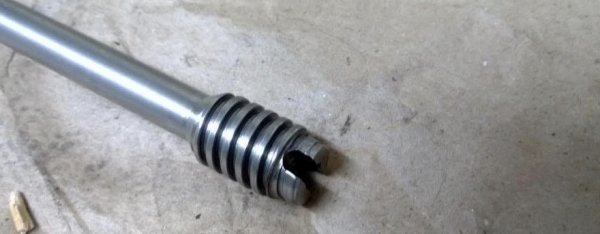-
Welcome back Guest! Did you know you can mentor other members here at H-M? If not, please check out our Relaunch of Hobby Machinist Mentoring Program!
You are using an out of date browser. It may not display this or other websites correctly.
You should upgrade or use an alternative browser.
You should upgrade or use an alternative browser.
What do I need to make this thread?
- Thread starter Djl338
- Start date
- Joined
- Jun 7, 2013
- Messages
- 10,145
Yes, the tool has to be the proper width, and have side clearance adequate for the spiral angle of the thread on the side advancing into the thread, and can be made almost vertical on the trailing side. The angle on the advancing side should be several degrees in excess of the spiral angle.
- Joined
- Aug 25, 2018
- Messages
- 107
How do you determine the angle on the advancing side?, is it a trial and error method or is there a formula. Using the compound at 29° or is this a different way of threading all together? Tried searching around and getting conflicting confusing info
Thanks!
Thanks!
- Joined
- Oct 14, 2014
- Messages
- 1,980
Make it a degree or two more than the helix angle

 www.bing.com
www.bing.com
also , make your tool a tad too narrow. Set compound at 90. advance it to get width just right.

helix angle calculator - Bing
Intelligent search from Bing makes it easier to quickly find what you’re looking for and rewards you.
also , make your tool a tad too narrow. Set compound at 90. advance it to get width just right.
- Joined
- Jun 7, 2013
- Messages
- 10,145
How do you determine the angle on the advancing side?, is it a trial and error method or is there a formula. Using the compound at 29° or is this a different way of threading all together? Tried searching around and getting conflicting confusing info
Thanks!
- Joined
- Jun 7, 2013
- Messages
- 10,145
The compound angle would be straight in for a square thread, which is 90 degrees to the axis; 29 degree thread is the acme thread, not a square thread, for it, the compound is set at 14 1/2 deg. If the thread you are dealing with has an angle to the axis, likely it is Acme, not square. If it is square, you can take a piece of stock the root diameter of the thread, and take a vee threading tool and trace a threading cut on it, and that will be the spiral angle; yes, there are formulas, but the "seat of the pants" approach works fine too; determine that spiral; angle, and add several degrees to it and grind the leading side of the tool to that angle, and as I previously said, the following angle can be nearly vertical and have sufficient clearance on it; if it is a square thread, feed straight in with the compound for each successive cut, for an Acme thread, feed in at 14 1/2 degrees with the compound.
- Joined
- Apr 30, 2015
- Messages
- 11,378
Only the most well equipped hobby shops would have a comparator- I have a humongous magnifying glass 
- Joined
- Aug 25, 2018
- Messages
- 107
The compound angle would be straight in for a square thread, which is 90 degrees to the axis; 29 degree thread is the acme thread, not a square thread, for it, the compound is set at 14 1/2 deg. If the thread you are dealing with has an angle to the axis, likely it is Acme, not square. If it is square, you can take a piece of stock the root of the threadi, and take a vee threading tool and trace a threading cut on it, and that will be the spiral angle; yes, there are formulas, but the "seat of the pants" approach works fine too; determine that spiral; angle, and add several degrees to it and grind the leading side of the tool to that angle, and as I previously said, the following angle can be nearly vertical and have sufficient clearance on it; if it is a square thread, feed straight in with the compound for each successive cut, for an Acme thread, feed in at 14 1/2 degrees with the compound.
Well, it doesn’t seem to have any angle to it, and I like the sound of a “seat of the pants” approach. I have a has parting tool that is about the same width I was thinking of working with as a starting point, and have lots of 4140 5/8”stock to practice with (outside diameter). Probably not purchasing an optical comparator, the magnifying glass seems a bit more practical for my level. Thanks for the great explanation
David


